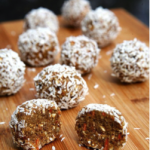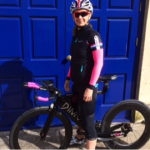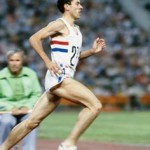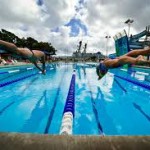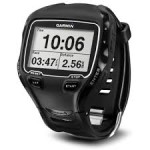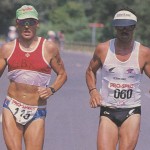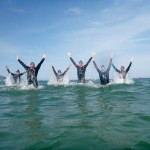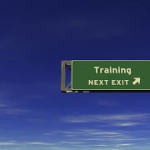Dublin 70.3 Race Report
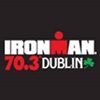 Last Sunday Beth and I raced the inaugral 70.3 in Dublin. After a race I like to be quite objective with my race reports in order that I and others can glean some information about the race, and learn from those things that worked well and those things that didn’t go quite to plan.
Last Sunday Beth and I raced the inaugral 70.3 in Dublin. After a race I like to be quite objective with my race reports in order that I and others can glean some information about the race, and learn from those things that worked well and those things that didn’t go quite to plan.
My objectives for this event
This was a build up race for us in our prep for IM Chattanooga in September but with most races I always aim to do as well as I can.
Swim – as ever try to be strong and get the swim done without it taking anything out of me
Bike – ride a solid bike leg aiming to put myself in a good position to run strongly
Run – aim was to run around 1:30 which I hoped would put me in sight of an age group podium
PRE RACE
On the Sunday before the race I had my last real hit out session with a run that included 20 x 3 min reps at 70.3 race pace with 1 min recovery jogs. After the session I felt like I had a bit of hayfever coming on but early hours of Monday I awoke with a sore throat. No excuses whatsoever but this developed into a cold then a chesty cough as the week went on. Come the Friday I made the decision I would race as I felt it was getting better and we spent the day sight seeing; which culminated in a great meal and a couple of pints of Guinness in a bar on O’Connell Street with some great live Irish music – the Guinness actually seemed to help my cold! Saturday was the usual racking of bikes, dropping of bags and race briefing all of which seemed to take forever as the swim start and T1 was an hours drive away from T2 and the brief.
SWIM
 Race morning felt pretty nervous which I haven’t been since Vitoria last year and this is definitely something to continue to work on. The swim takes place in Scotsman’s Bay, Dun Laoghaire (pronounced Dun Leary) and the 1 lap anti clockwise swim was set off in rolling, wave starts; there is a nice video of the swim start here. We were split into gender and age group waves that set off at 10 min intervals but you entered in a very orderly fashion down a slipway into the Irish Sea with the timing mat at the bottom of the slip way so there way no drama of the mass start. The swim was un-dramatic, although was about 300m long! The water temperature was reported to be 14.9 degrees C and there was a bit of a swell running that made sighting awkward. I came out in 40:40 which was 13th in my AG but as it turns out nicely placed with those who would be in the mix as you can see from the results below. The exit is steep but multiple helpers did a grand job pulling you out.
Race morning felt pretty nervous which I haven’t been since Vitoria last year and this is definitely something to continue to work on. The swim takes place in Scotsman’s Bay, Dun Laoghaire (pronounced Dun Leary) and the 1 lap anti clockwise swim was set off in rolling, wave starts; there is a nice video of the swim start here. We were split into gender and age group waves that set off at 10 min intervals but you entered in a very orderly fashion down a slipway into the Irish Sea with the timing mat at the bottom of the slip way so there way no drama of the mass start. The swim was un-dramatic, although was about 300m long! The water temperature was reported to be 14.9 degrees C and there was a bit of a swell running that made sighting awkward. I came out in 40:40 which was 13th in my AG but as it turns out nicely placed with those who would be in the mix as you can see from the results below. The exit is steep but multiple helpers did a grand job pulling you out.
All the bike bags were on racks in a tent as is normal at these events and I found mine and pulled on a long sleeved skins top to keep me at a good temperature and protect from the” Irish sunshine” on the bike. I was away well and pleased with myself for a reasonably slick transition all things considered.
BIKE
 The bike course is a beautiful relatively flat course where you cycle on closed roads firstly straight into and through Dublin city centre the out on a one lap route that ends in Phoenix Park. The road surface in the main is pretty ropey to be honest and there were some significant pot holes. There are also at least 30 to 40 speed bumps on the course with 22 of them in the last few miles coming into Phoenix Park. These coupled with the road conditions and the rain shower we had made for some crashes and also the usual bottles and bits of bikes littering the course. I felt like I cycled well and only remember a couple of guys passing me and came off the bike in good shape in 2:33.
The bike course is a beautiful relatively flat course where you cycle on closed roads firstly straight into and through Dublin city centre the out on a one lap route that ends in Phoenix Park. The road surface in the main is pretty ropey to be honest and there were some significant pot holes. There are also at least 30 to 40 speed bumps on the course with 22 of them in the last few miles coming into Phoenix Park. These coupled with the road conditions and the rain shower we had made for some crashes and also the usual bottles and bits of bikes littering the course. I felt like I cycled well and only remember a couple of guys passing me and came off the bike in good shape in 2:33.
RUN
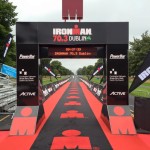 This is my strength and I had high hopes of keeping to the 1:30 target I ghad set myself. The run course is three laps around Phoenix Park and is pretty much supported the whole way round. At the end of lap 1 I stopped to have a pee in a portaloo and this was a good move in terms of I ran much better afterwards but took a few precious seconds so perhaps I should have peed on the bike. Technique wise I tried to run light, using a heel strike and hold my hips high with high cadence. It’s never easy in a triathlon but I felt my technique stayed reasonable throughout although I could definitely have run with a higher cadence.
This is my strength and I had high hopes of keeping to the 1:30 target I ghad set myself. The run course is three laps around Phoenix Park and is pretty much supported the whole way round. At the end of lap 1 I stopped to have a pee in a portaloo and this was a good move in terms of I ran much better afterwards but took a few precious seconds so perhaps I should have peed on the bike. Technique wise I tried to run light, using a heel strike and hold my hips high with high cadence. It’s never easy in a triathlon but I felt my technique stayed reasonable throughout although I could definitely have run with a higher cadence.
The crowd support on the run was fantastic enthusiastic! My first two laps were pretty much on target and I felt that I was accelerating as the race went on which on a multi lap course is a great mental boost as you spend the entire race overtaking people. I ran a 1:32 so was happy with that time and it gave me a finish time of 4:56:19 and 5th in my AG. No World Championship slot for me although it rolled to 3rd place however Beth managed to bad a roll down slot and therefore we will be making the trek across to Mooloolaba in September 2016. Still time for me to join her racing though!
Summary
Swim – I stayed focused and got it done without it taking anything out of me
Bike – I’m in good and felt I rode reasonably strongly without it killing me for the run.
Run – A strong run, not as fast as some but I felt like I tried hard.
NUTRITION
Overall I went in with a plan and stuck to it and didn’t feel I needed anymore.
Breakfast:
We had breakfast in the hotel: cereal with some fruit and some homebaked Guinness Brown Bread with honey and almond butter. Yes all you Paleo people will be shouting at this.
Bike:
One bottle with 4 Overstims gels in it topped up with water.
One bottle with some Overstims carb drink
1 ½ Powerbars withy the whole bar cut in half.
1 x Double Expresso Clif Shot Gels (caffeinated)
Run:
1 x Double Expresso Clif Shot Gels (caffeinated)
2 x Overstims gels
Water
Plan was to eat half a bar every 20 mins on bike then take caffeinated gel at 1 hr 20 then drink from gel bottle every 20 mins to finish. On run it was 1 gel every 25 ish minutes.
OUTCOMES
Positives:
- All my gear worked great and I did not get too hot or cold. Huub wetsuit, Cervelo P3, Adidas Tempo run shoes – I’ve run in Adidas Tempo since 2012 if it ain’t broke don’t try and fix it
- I handled the mental side well once the race started but was nervous before. In the swim and the bike and raced my own race. Felt I ran strongly
- Nutrition worked pretty well in terms of not bonking at all
- Confident that if things go well I can put together a faster time
Negatives / Work On’s:
- Race nerves pre race
- Possibly nutrition. I need to think how to transfer this plan to Ironman
- Push harder on swim and bike – however cognisant that “you run for dough” so don’t want to overcook it
All in all a great race and one I would certainly do again.
 Thank goodness for Clif Bar!! I have been a bit busy with work, getting the house ready to put up for sale and looking for a new house, (or motorhome -stay tuned!) so I haven’t had the time I would have liked to experiment with nutrition bars. Enter Clifbars - an ethical company that takes whole food seriously. Plant based nutrition AND free of hydrogenated oils and high fructose corn syrup who have sponsored me on this Ultraman journey AND as well as fuelling me have sent me some cool kit!
I did find the time, however, to make these Super Simple and easy to put together (right up my alley!) Onigiri. A Japanese rice ball popular in ultra race aid stations due to its cooling effect on the body – loaded with carbohydrates, electrolytes and salt and easy to digest to boot. The photo is google image (mine weren’t so pretty) and I got the recipe from :
Thank goodness for Clif Bar!! I have been a bit busy with work, getting the house ready to put up for sale and looking for a new house, (or motorhome -stay tuned!) so I haven’t had the time I would have liked to experiment with nutrition bars. Enter Clifbars - an ethical company that takes whole food seriously. Plant based nutrition AND free of hydrogenated oils and high fructose corn syrup who have sponsored me on this Ultraman journey AND as well as fuelling me have sent me some cool kit!
I did find the time, however, to make these Super Simple and easy to put together (right up my alley!) Onigiri. A Japanese rice ball popular in ultra race aid stations due to its cooling effect on the body – loaded with carbohydrates, electrolytes and salt and easy to digest to boot. The photo is google image (mine weren’t so pretty) and I got the recipe from :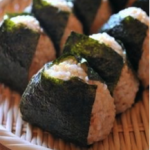 Eat and Run: My Unlikely Journey to Ultramarathon Greatness
Eat and Run: My Unlikely Journey to Ultramarathon Greatness
